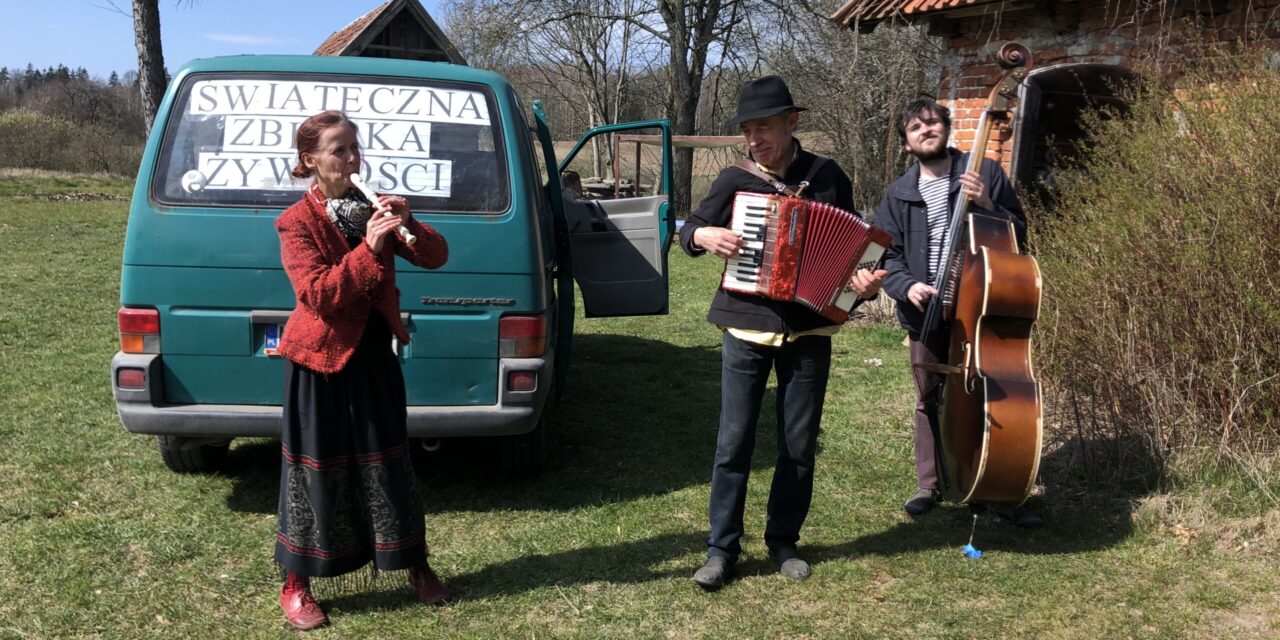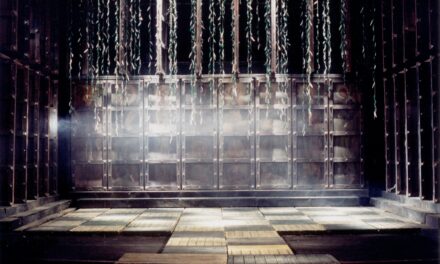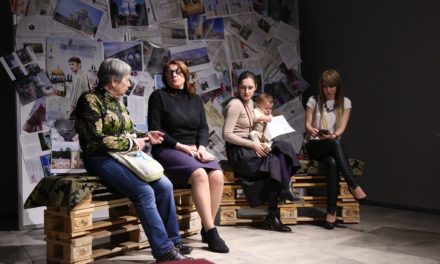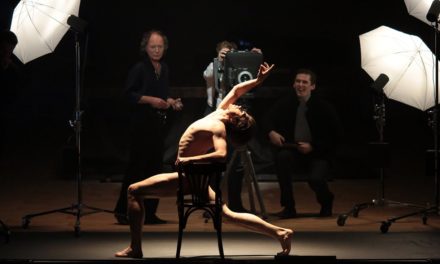As the Węgajty Theater [1] was launching an appeal for Easter food donations for homeless people locked away in quarantine in a hostel in the city of Olsztyn in northeast Poland, Warsaw’s Międzypokoleniowy Chór Ruchowy (Intergenerational Choir of Movement) continued, via Zoom, rehearsals they had started before the pandemic. With its activities coordinated by the Strefa WolnoSłowa [2] Foundation, the Choir aims to support those over (and under) fifty, keeping them active during lockdown. In July 2020, the Choir appeared at the Skaryszewski Park in Warsaw, which was hosting an open-to-all performance of choreography – part dance, part gymnastics – that members of the Choir had perfected separately, each in their own home. They had come together, close at last, almost shoulder to shoulder, although social distancing rules still applied. Their motivation – the desire to lift the spirits of their audience – also underlay the social media activities of the Klancyk Improv Theater [3]: a group of people who are “always in the mood for jokes and pranks.” Their Codzienne trudnoś ci (Everyday Difficulties) podcast, and their Kartka z kalendarza (Page from a Diary) series, both used laughter as a means of alleviating the drudgery of home isolation. Klancyk reminded their audience, somewhat tongue-in-cheek, that “time still passes, it’s just that we’re not moving all that much,” [4] and encouraged them to come together to celebrate, among other things, Hamburger Day (28 May), World Speed Control Day (16 April) and Getting Back in Touch After Many Years Day (21 May).
The pandemic is yet another crisis social theater must cope with. Crises drive the creative energy of those working outside the framework of stable and secure mainstream institutions. For these groups, emergencies become a mode of being, defined by a certain dynamic and certain values. Thus, rather than threaten their expression, crises stir and inspire independent creatives, prompting them to respond. Champions of emergency, they do not regard a crisis as a temporary state, assessed based on what will happen once it comes to an end. “A crisis is valuable because it is characterized by a (paradoxical) stable instability, the certainty of uncertainty, being ever open to flux.”[5]
This is because social theater is a theater of change, in a dual understanding of the term: it not only responds immediately to any changes to society, but at the same time, these changes are the goal it sets itself. “It is a theater that facilitates individuals, groups and communities in finding their own ways to meet their own needs, improve their social functioning, and eventually overcome unhappy situations.”[6] Theatrical means that are applicable beyond the stage become social theater’s main instrument: this kind of theater uses theater to reach beyond the theater. [7] Its main aim is to work for the benefit of the local community, in the broadest understanding of the term: a close-knit group with a strong sense of belonging, which manifests itself in the group’s ability and willingness to do things together. Social theater gives preliminary diagnoses: it looks at situations and events, analyzes them, and seeks to establish their causes. Remedial measures are put forward as a result of such diagnoses; these measures are cures, conceived of as a procedure: theater is administered to a community which is at once being established and strengthened in the process.[8]
These clinical metaphors bring to mind the insights of actor, director, and medical student Lidia Zamkow (1918–1982), who distinguished between two contrasting types of theater: the laboratory, where “scientific research goes on” (without offering any diagnosis of the world as it is), and the ambulatory care center, outpatient clinic, visited day in, day out by “about a thousand potential patients.”[9] The ambulatory care metaphor encompasses a number of wartime and hospital tropes: at their emotional core, they are temporary, makeshift and transitory. Although the ambulatory care center offers the opportunity to “put one’s thoughts on what goes on around us […] into words,”[10] the nurses and orderlies working there make no attempt at a conclusive diagnosis but focus instead on offering preliminary, makeshift insights. This is because adaptability to change is the main forte of the theater of ambulatory care, and flexibility is its virtue. The ambulatory care center is a medical post on the front line, where first aid can be administered before the injured are seen by consultants. According to theater historian and theoretician Joanna Krakowska, “irrespective of the shape it takes in artistic terms, the concept of the theater of ambulatory care entails recognition of its temporary and makeshift quality, and its readiness to serve.”[11] The social practice of theater consists in actions imbued with care and tenderness and released by unlocking the potential shown via collective methods. This is not metropolitan or mainstream theater: destined to remain local, it will stay close to its community, for which it feels a sense of responsibility. While laboratory theater takes on classic literary works, theater of ambulatory care remains constantly on the move, fueled by subsequent crises as it comes up with, and implements, one remedy after another.
Thus, one can say that, from the point of view of social theater, crises (including the crisis that is the current pandemic) are like sparring partners: they give social theater a boost and help it grow. This time, however, the crisis in question is extremely complex: the pandemic has caused damage to many aspects of life in society. Covid is a grenade whose huge blast power has a direct impact on everyone, including members of theater groups. As Rebecca Solnit has observed, “the word ‘crisis’ means, in medical terms, the crossroads a patient reaches, the point at which she will either take the road to recovery or to death.”[12] Thus the pandemic can be seen as an obstacle, a challenge, an opponent, or even a deadly enemy; a disruption to the continuity of creative work, and a serious threat to the community, which is the focus of social theater’s activity in both its creative and day-to-day aspect. For theater, the current situation is both a growth opportunity and a threat to its wholeness. What is of interest to us, however, is not so much what the pandemic can do to present-day theater, as what kind of partner (or opponent) the pandemic will find in social theater.
The ambulatory care mode in which social theater operates makes its insights into the reality of the pandemic impossible to ignore. History has shown that social theater’s instincts are often right. Ways of alleviating the impact of local and global crises proposed by this strand of theater make it easier to adapt to challenges; to expose taboos and introduce buried issues into the social store of images; to defuse social tensions or, conversely – if need be – to arouse public debate, sharpening its focus around topical issues. Peregrinations – a custom once observed by the Gardzienice Theater, and maintained at Węgajty till this day – are one example of how social theater operates: the crux of such occasions is that actors and local inhabitants come together, side by side. During peregrinations, instruments peculiar to theater are not used for artistic ends: they are there to restore human relationships. Poland’s politically engaged alternative theater in the early 1970s provides a different sort of example: productions defied the established social and political order, and thus they offered an up-to-date diagnosis of the world as it was. As one of “the most sensitive social seismographs,”[13] student theater was known not just as an emerging theater: it was commonly referred to as theater of the young intelligentsia [14] – at a time when the impact of that class on social reality was paramount. Theater of ambulatory care, in whatever guise, makes a real difference to society and expands the boundaries of discourse: its community-based activities usually being unassuming rather than spectacular, it nonetheless steps boldly into the thick of it, taking a stance on the issues of the moment.
When theatrical diagnoses and remedies are seen to be effective, they are frequently absorbed by the mainstream, leaving theater with no choice but to look for even more unorthodox paths. According to sociologist Aldona Jawłowska, “although cultural dissenters seek to reject culture in all its aspects, defiance is a cultural phenomenon peculiar to the very culture which is being called into question.” [15] Jawłowska seems to imply there is a connection, or even generic unity, between dominant and alternative cultures. The insights offered by theater of ambulatory care are often accurate, and suitable to the ailments of the contemporary world precisely because this type of theater shares its roots with the dominant culture.
What exactly is the crux of the “ambulatory care” mode of operation? Well, the crisis brought about by the pandemic generates ever-new needs, to which theater of ambulatory care responds in a temporary and makeshift manner, by experimenting and coming up with new forms and new content… only to then abandon them immediately in order to test out new solutions. This mode of seeking a cure bears a striking resemblance to the struggle of medical personnel treating Covid-19 patients in hospitals; meanwhile, scientists are working away in their labs to come up with an effective vaccine and/or medication. There is an analogy between the tactics of doctors and those deployed by creatives working in social theater. Both groups are on the front line: therefore, both opt for tactical, makeshift solutions, “tailor-made” to fit the moment and the circumstances, and effective in so far as imagination – the fantasy of the bricoleur [16] – does not fail those who implement them. Michel de Certeau has described tactic as an “art of the weak,” which operates in isolated actions, blow by blow. It takes advantage of “opportunities” and depends on them, being without any base where it could stockpile its winnings, build up its own position, and plan raids.[17]
Though this may be a weakness, there may be a method in it, and a certain unintrusive wisdom; not unlike Lévi-Strauss’ untamed thinking [18], or Clifford Geertz’s local knowledge. [19] This is what makes the world, as seen by those working in social theater, so interesting. What does alternative theater make of the current situation? What are the filters through which it views the world? What are its proposed remedies for the social and emotional impact of the pandemic?
Preliminary insights offered by theater of ambulatory care make for a very interesting category. They are not based on indisputable diagnoses, borne out by numerous studies – diagnoses of this kind could only be provided by laboratory theater. Nor do they result in administering reliable, crisis-tested treatment patterns. Theater of ambulatory care offers first aid – a dressing and pain relief – rather than targeted therapy. Insights offered by this type of theater resemble early stages of treatment: timewise, they come first; in functional terms, they are essential. The diagnoses and cures offered by social theater come about as a result of its relationship with the world: creatives encounter a community which has a strong sense of its own subjectivity, and whose needs determine the goal and scope of activity. In addition, creatives are faced with an upheaval, or rather upheavals: a health emergency and an economic, social, emotional, and political crisis. The driving force behind these crises is impersonal, but it has agency. New ideas, new prospects, and new vistas emerge from this trilateral encounter between an artist’s sensibility, the needs of a community, and an emergency.
In her piece on holding on to hope in the face of the new virus, Rebecca Solnit has likewise stressed how peculiar this process of emergence is in a crisis. She points out that, etymologically, “emergency” “comes from emergence or emerge, as if you were ejected from the familiar and urgently need to reorient.”[20] When the human community is suddenly forced to adjust to a new situation, theater of ambulatory care comes to the rescue – trained to operate in constant flux, born out of uncertainty lurking “in the background, as it does in human existence.”[21] This type of theater is driven, in its here and now, by operating “in a utopian light”[22] – a mode of operation fueled by critical consideration of the current state of things,[23] and by maintaining a hopeful outlook on the future – although, as philosopher Jolanta Brach-Czaina has observed, the hope rests upon “what can possibly emerge from the background.”[24]
Meanwhile, Michel Foucault has pointed out that “emergence is always produced through a particular stage of forces.” Foucault drew on a contention by Nietzsche, who defined emergence (Entstehung) as “the moment of arising”: the moment when an idea merely takes root.[25] Thus, if we bring our attention back to what goes on in the social theater of ambulatory care, we will see that no analysis of the concept of Entstehung will provide us with a comprehensive diagnosis of reality; instead, it will only offer preliminary insights. All it will do is expose the play of the forces comprising a crisis: “this interaction, the struggle these forces wage against each other or against adverse circumstances, and the attempt to avoid degeneration and regain strength by dividing these forces against themselves.”[26] Where, then, does it hurt, and what are social theater’s recommendations for alleviating the observed symptoms?
Pandemic emergencies identified by social theater are either perceived in the context of what members of a crisis-ridden community feel as individuals, or, in much broader terms – within the spectrum of the social and political issues preoccupying the community in question. This is because ambulatory care centers, as we know them, are highly specialist: they are staffed by paramedics of different métiers, using a variety of means and instruments as they come to their patients’ rescue. Nonetheless, the theater’s urgent response team have a common goal, which is “to make people happy.”[27] Theaters think of “ideal communality” in utopian terms: in other words, they regard the adjective “ideal” as synonymous with “appropriate” or “suitable,” rather than “unreal,” “impossible” – quite unlike Max Weber’s ideal types, a cognitive instrument used by academics. This distinction highlights yet another difference between laboratory theater and theater of ambulatory care. The utopian nature of the latter – in other words, the fact that its gaze is fixed on a prospective better world – is not a figment of something that does not exist, but rather a journey, an incessant journey towards what might be moving further off, might be unattainable, or achievable only in glimpses, but what is nevertheless real.[28] Understood in this manner, the utopian quality inspires hope that the treatments offered by social theater will prove effective.
From our point of view – and in keeping with Weber’s original idea – the ideal type is a theoretical construct, a cognitive fiction meant to help us study, and understand, the reality of social theater.[29] During the pandemic, we have talked to numerous creatives working in social theater. Our interviews were conducted as part of two distinct research projects: a study of the anthropological and social activity of the Węgajty Theater [30] (and thus those who collaborate with it) – this was possible thanks to a research grant coordinated by the Institute of Art, Polish Academy of Sciences. The other scheme, launched by the Theatre Institute in Warsaw, was called A Study of Theater Workers in the Pandemic. Based on our interviews, conducted as part of these two programs, we have identified three ideal types of actions, which demonstrate what has emerged from the point of view of theaters of ambulatory care from the background of the pandemic. The first two types – the therapeutic approach and conjuring – are related to the crisis of the individual, while the third – revolution – is linked primarily to the crisis of the community.
FOOTNOTES
1. The Węgajty Theater was founded in 1986, in a village of the same name, by husband and wife Wacław and Erdmute Sobaszek. Till this day, the Sobaszeks’ barn, in the northeast region of Warmia, is home to a theater steeped in Poland’s folk tradition. The couple breathe new life into traditional forms of drama, related to the four seasons, and they uphold the custom of festive peregrinations: at Easter, they go from door to door with an Alilujka (see footnote 43). They sing carols on Christmas, and celebrate Mardi Gras to mark the transition into Lent. Owing to the subject matter of their performances, and the nature of their activities, the Węgajty Theater can be regarded as anthropological theater, a place of social and cultural experimentation. See http://teatrwegajty.eu.
2. Set up in 2012, the Strefa WolnoSłowa Foundation explores the boundaries between art and civic intervention. The name of the Foundation is an untranslatable pun: “strefa wolnocłowa” means a duty-free zone; “Strefa WolnoSłowa” means “free word zone,” implying freedom of speech. Since 2015, the Foundation has collaborated with the Powszechny Theater in Warsaw, where it puts on its own productions and runs Stół Powszechny (Communal Table), a café and workshop space. Productions by Strefa WolnoSłowa feature Polish people from diverse backgrounds; the group draws on true stories and the experiences of real people to address topical issues, and encourages audiences to take an active stance towards social problems.
3. Klancyk was founded in Warsaw in 2006, which makes it Poland’s oldest improv theater. Writers, musicians and actors are invited to perform with Klancyk; their words and music provide members of the group with improvisation material. See https://klancyk.pl.
4. Klancyk (@Klaaancyk),“Co dzisiaj warto robić,” Facebook, April 23, 2020, https://www. facebook.com/Klaaancyk/posts/10163444477500207.
5. Dariusz Kosiński, Teatra polskie. Historie (Warszawa: PWN, Instytut Teatralny im. Z. Rasze wskiego, 2010), 486. Also cf. the (markedly different) English version: Dariusz Kosiński, Performing Poland: Rethinking Histories and Theatres, trans. Paul Vickers (Cardiff: Performance Research Books, 2019).
6. Guglielmo Schininá, “Like a Ham in a Temperance Hotel: Healing, Participation and Education in Social Theatre,” in Dramatherapy and Social Theatre: Necessary Dialogues, ed. Sue Jennings (London: Routledge, 2009), 38.
7. In his remarks on “using theatre to reach beyond theatre,” theatre and performatics scholar Dariusz Kosiński references the work of Tadeusz Kantor (1915–1990) and Jerzy Grotowski (1933–1999). The means of expression used by these two artists, and related (meta)commentaries on the state of the world we live in, have little in common with socially engaged theater (in whatever understanding of the term). See Kosiński, Teatra polskie, 206.
8. To grasp the full nature of social theater, it would be best to amalgamate the two terms used to describe it in English-language sources: “social theater” and “applied theater.” A combination of the two gives us “socially applied” (or “applicable”) theater. See Philip Taylor, Applied Theatre: Creating Transformative Encounters in the Community (Portsmouth: Heinemann, 2003).
9. Lidia Zamkow,“Nie uznaję teatru bez tekstu,” interview by Krzysztof Miklaszewski, Scena, no. 1 (1971): 5.
10. Lidia Zamkow, “Moje mądre przyjemności,” Polska, no. 3 (1968): 31.
11. Joanna Krakowska, PRL: Przedstawienia (Warszawa: PIW, Instytut Teatralny im. Z. Raszews kiego, Instytut Sztuki PAN, 2016), 206.
12. Rebecca Solnit, “The Impossible Has Already Happened: What Coronavirus Can Teach Us About Hope,” Guardian, April 7, 2020, https://www.theguardian.com/world/2020/apr/07/what-corona virus-can-teach-us-about-hope-rebecca-solnit.
13. Konstanty Puzyna, “Rola społeczna teatrów studenckich,” in Syntezy za trzy grosze (Warszawa: PIW, 1974), 169, http://www.encyklopediateatru.pl/ksiazka/409/syntezy-za-trzy grosze/strona/177.
14. Wojciech Dudzik has highlighted the ever-increasing scope of the term “alternative theater” in his article “O teatrze alternatywnym,” Konteksty 49, no. 2 (1995): 74.
15. Aldona Jawłowska, Drogi kontrkultury (Warszawa: PIW, 1975), 103.
16. According to Claude Lévi-Strauss: “the ‘bricoleur’ is still someone who works with his hands and uses devious means compared to those of a craftsman. The characteristic feature of mythical thought is that it expresses itself by means of a heterogeneous repertoire which, even if extensive, is nevertheless limited. It has to use this repertoire, however, whatever the task in hand because it has nothing else at its disposal. Mythical thought is therefore a kind of intellectual ‘bricolage’ – which explains the relation which can be perceived between the two. […] The ‘bricoleur’ is adept at performing a large number of diverse tasks; but, unlike the engineer, he does not subordinate each of them to the availability of raw materials and tools conceived and procured for the purpose of the project. His universe of instruments is closed and the rules of his game are always to make do with ‘whatever is at hand.’” Claude Lévi-Strauss, The Savage Mind, trans. George Weidenfield (Chicago: University of Chicago Press, 1966), 16–17.
17. Michel de Certeau, The Practice of Everyday Life, trans. Steven Rendall (Berkeley: University of California Press, 1988), 37.
18. See Lévi-Strauss, The Savage Mind.
19. See Clifford Geertz, Local Knowledge: Further Essays in Interpretive Anthropology (New York: Basic Books, 1983).
20. Solnit, “The Impossible Has Already Happened.”
21. Philosopher Jolanta Brach-Czaina uses the metaphor of the background to describe the nature of the world: “The background is matter from which shape emerges. […] It is chaos, in that there is nothing distinctive about it, and the very fact of distinction is an act of separation from the background.” Jolanta Brach-Czaina, Szczeliny istnienia (Warszawa: Dowody na Istnienie, 2018), 97.
22. Paul Celan, “Meridian: Speech on the occasion of receiving the Georg Büchner Prize,” Darmstadt, 22 October 1960, in Collected Prose, trans. Rosemarie Waldrop (New York: Routledge, 2003), 51.
23. See Dorota Sieroń-Galusek, Łukasz Galusek, Pogranicze: O odradzaniu się kultury (Wrocław: Kolegium Europy Wschodniej, 2012), 48.
24. Brach-Czaina, Szczeliny istnienia, 97.
25. Michel Foucault, “Nietzsche, Genealogy, History,” in Language, Counter-memory, Practice: Selected Essays and Interviews, trans. Donald F. Bouchard and Sherry Simon, (Ithaca: Cornell University Press, 1977), 148–149.
26. Foucault, “Nietzsche, Genealogy,” 149.
27. “The point of working in the arts is to make people happy. I mean it, ”said academic Grzegorz Godlewski, when interviewed about the ideas underlying social activity within the arts. “The point is to provide people with whatever they need to get more out of their potential.” Grzegorz Godlewski, “Potężne zbiorniki znaczeń,” interview by Dorota Hall and Tomasz Rakowski, (op.cit.,), no. 3–4 (2005): 7.
28. Krzysztof Czyżewski, “Jestem człowiekiem małych liczb,” interview by Grzegorz Godlewski, Nowe Książki, no. 11 (2008): 5, http://www.encyklopediateatru.pl/artykuly/62179/jestem-czlowiekiem malych-liczb.
29. See Max Weber, “‘Objectivity’ in Social Sciences and Social Policy,” in Methodology of Social Sciences, trans., ed. Edward A. Shils and Henry A. Finch (New Brunswick: Transaction Publishers, 2011), 49–112.
30. Research funded by Poland’s National Science Centre, no. 2017/26/E/HS2/00357.
This article was translated by Joanna Błachnio and first published by Pamiętnik Teatralny 2020/4. For the original article go here.
This post was written by the author in their personal capacity.The opinions expressed in this article are the author’s own and do not reflect the view of The Theatre Times, their staff or collaborators.
This post was written by Katarzyna Kułakowska, Katarzyna Kalinowska, Olga Drygas, Michał Bargielski.
The views expressed here belong to the author and do not necessarily reflect our views and opinions.

















